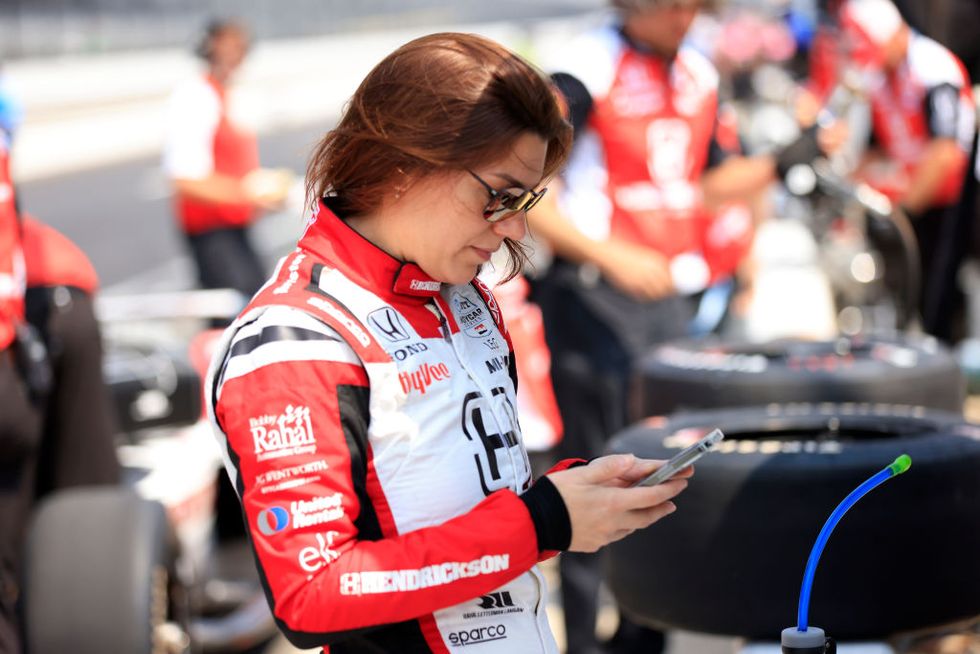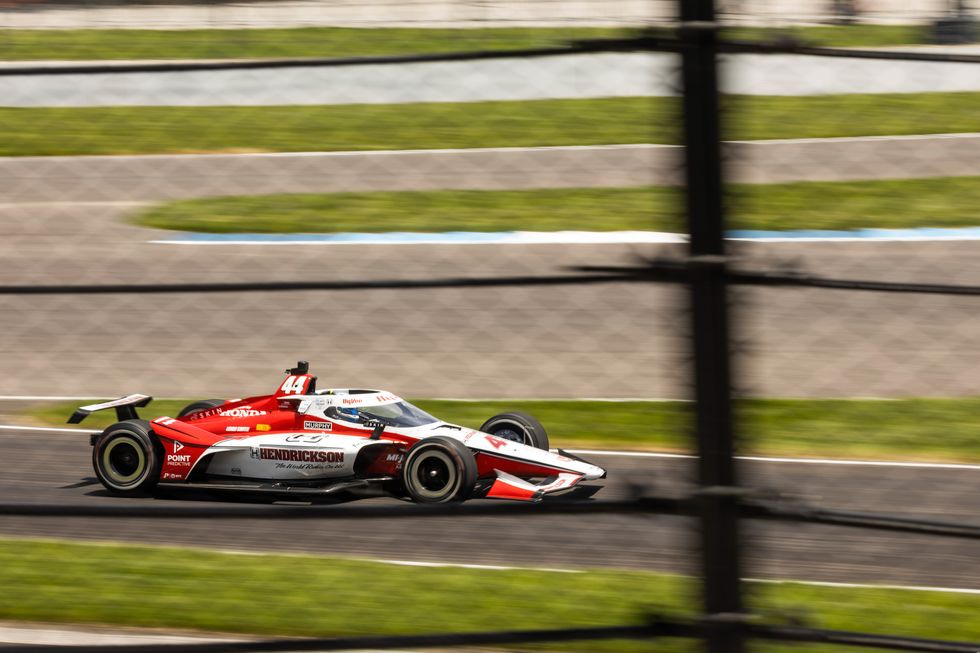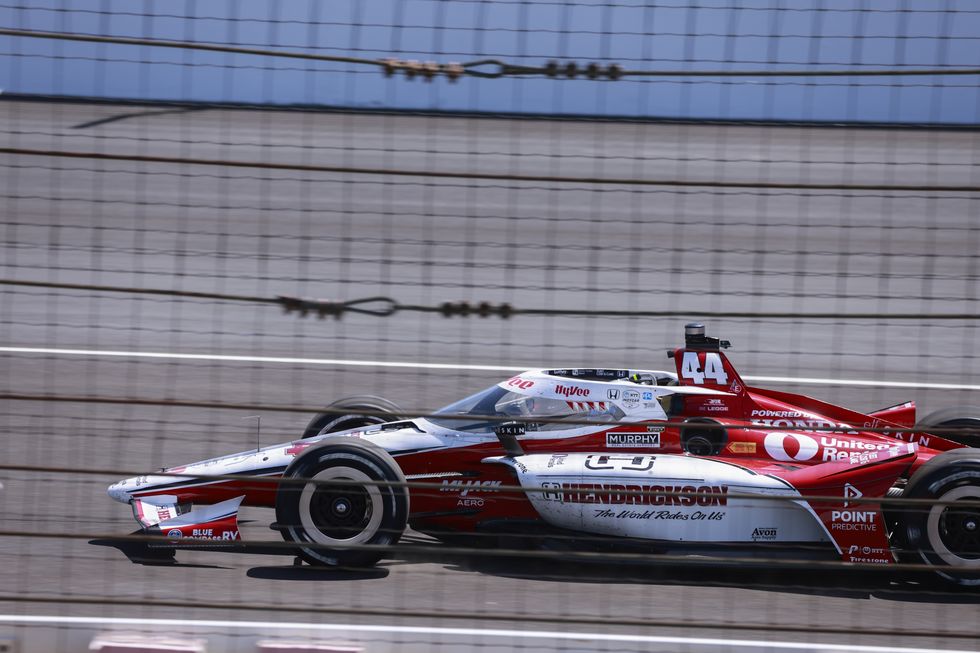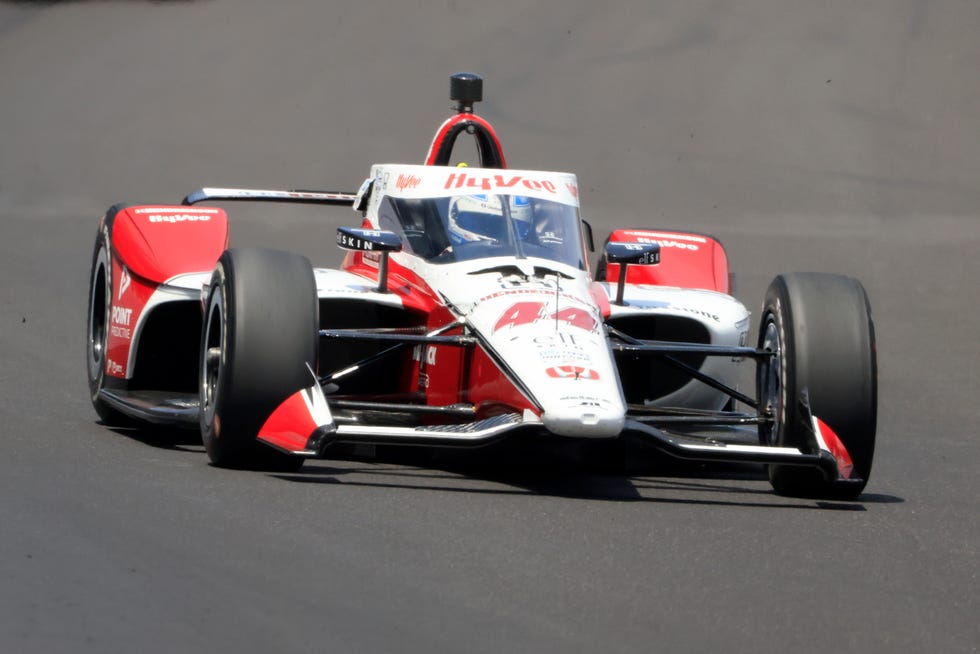Katherine Legge didn’t win this year’s Indianapolis 500. In fact, she finished last.
Her attempt at the 500 was the “craziest week in the history of everything,” she told Road & Track—and she wasn’t kidding.
“I’m like: ‘Okay, was I really bad in a previous life?’” Legge laughed. “You couldn’t script a movie like this. You couldn’t write a book like this. Nobody would believe you. I’m going to need three weeks of vacation and a bottle of tequila.”
The Indy 500 on Sunday was Legge’s first IndyCar race since 2013, when she also ran the 500 as a one-off. Since then, she’s raced sports cars in IMSA, electric open-wheel cars in Formula E, and even stock cars in the NASCAR Xfinity Series.
But Indy this year brought constant misfortune for Legge, including crashes, a loose wheel, drama during qualifying, and a car that just couldn’t get up to speed. Once the 500 began, she had a dire exit from her pit box, sliding to the left and almost hitting a crew member from another team. She ran just 41 of the 200 laps before retiring from the race.
“We don’t know whether it’s a toe link, or—“ Legge told the NBC broadcast once she got out of the car. “We tried changing that, but maybe it’s the steering rack or something. We’re going to try and fix it and get back out. There’s not much we can do multiple laps down, but it’s still good experience.”
Legge entered this year’s 500 as a fourth car for Rahal Letterman Lanigan Racing, a Honda team that won the race with now-part-time IndyCar driver Takuma Sato in 2020. Before she got in the car, she thought she had a chance to finish in the top six.
But reality set in quickly. During her first test at Texas Motor Speedway in April, Legge had two main challenges: first, the nerves.
“Texas was bonkers,” Legge said. “It’s been a while since I’ve been in anything that quick. When I got in the gas, I immediately came back off. The first time I kept it flat after about six or seven laps of lifting, I’m like: ‘Why do people do this? It’s so fast.’”
Then there was the car.
“I went to Texas, and I’m like: ‘Oh, yeah, this is going to be a struggle,’” Legge told Road & Track the Friday before the race. “Then we came here, and we thought: ‘Nah, it’ll be okay, because Indy’s a different animal.’ But it was still a struggle.
“We’re getting [aerodynamic] drag from somewhere, and we don’t know where. We’re all very perplexed and scratching our heads, because we’ve got some really smart people and some really good drivers. We’re not sure why we are where we are, and we’re out of time. If anybody knows and wants to tell me, that would be great.”
In spite of the car, Legge became the fastest woman in the history of Indy 500 qualifying at 231 mph, claiming the 29th starting spot ahead of every other car on her team. Since 34 cars were going for 33 spots this year, Legge’s teammates—Christian Lundgaard, Jack Harvey, and Graham Rahal, who are all IndyCar regulars—had to go to last-chance qualifying to fight for them.
“I think that was just the way the cookie crumbled,” Legge said. “It’s so dependent on the conditions, like the heat and the track and everything else, so I was fortunate. You’re sitting there like, ‘Oh, please let me be in, I really don’t want to be racing for the last row.’ You’ve got the emotions of that, then the next day, you’ve got the emotions of your teammates bumping each other out. You don’t want to be fighting each other to get in the race.”
Rahal was ultimately the odd car out, getting bumped by Harvey in the final seconds of last-chance qualifying. But days later, Legge and Chevy driver Stefan Wilson had a nasty crash in practice while she was running about 220 mph. The cars in front of Legge checked up, she didn’t know, then she clipped Wilson, sending them both into the outside wall. High-speed clips like that are common at Indy—in the race, for example, Scott McLaughlin ran into the back of Simon Pagenaud while cars wrecked in front of them, sending Pagenaud into the wall as well. (“He was checking up, and I had nowhere to go,” McLaughlin said.)
Wilson went to the hospital with a fractured vertebrae, and Legge said she felt “horrible about the whole situation.” Wilson thenand withdrew from the race, prompting Honda to let Rahal switch manufacturers for the weekend and take his place.
Like Legge said, you couldn’t script it.
“It’s been a hell of a week,” she told the Indy Star after the crash.
But the week was good, in some ways. To Legge, her qualifying effort was a reminder to potential teams and sponsors that at 42 years old, she’s still got it.
“I’ve still got a few good years left in me,” Legge told Road & Track. “I think [my performance] has done a lot for the people who’d forgotten about me, maybe, or didn’t know who I was. It’s shown those people that other people still have faith in me, and I can still drive a race car.
“The thing is, you can only go as fast as the car goes. If I’ve gotten the most out of [a] car and haven’t made any mistakes, I’ll be proud of myself. I don’t care what anybody else says.”
The week was also a chance to see how IndyCar has evolved—and how many women are at the track cheering for her, even if there are still men who think she “shouldn’t be driving.”
“The support from the women has been way cooler now than it was 10 years ago,” Legge said. “There’s this ‘girl power’ ethos. There’s no more, like, ‘I want to be the best girl,’ or any bitchiness. I think now, there’s this understanding that we can all support each other and lift each other up, and I feel it with the fans. They’re like: ‘You’re driving for every woman out there’ or ‘Now my daughter thinks she can be anything she wants to be.’”
Indy was hard for Legge. She didn’t have the car to win—honestly, she barely had the car to qualify—and she had to fight with a lot of realities: She’s not young enough to ride this wave of girl power forever, and she may never come back to the Indy 500.
But she’s certainly going to try.
“If you want something badly enough, you make it happen,” she said. “You work on finding the sponsors, talking to the teams, or whatever it is that you need to do. I don’t think I’m ever giving up racing. I would like to do more Indy 500s if anybody will have me back, I still have some NASCAR road course aspirations, and I really want to do Bathurst and Le Mans.
“But first: vacay.”
Contributing Editor
Alanis King is a transportation editor at Business Insider, and she previously worked as a staff writer and editor at Jalopnik.







